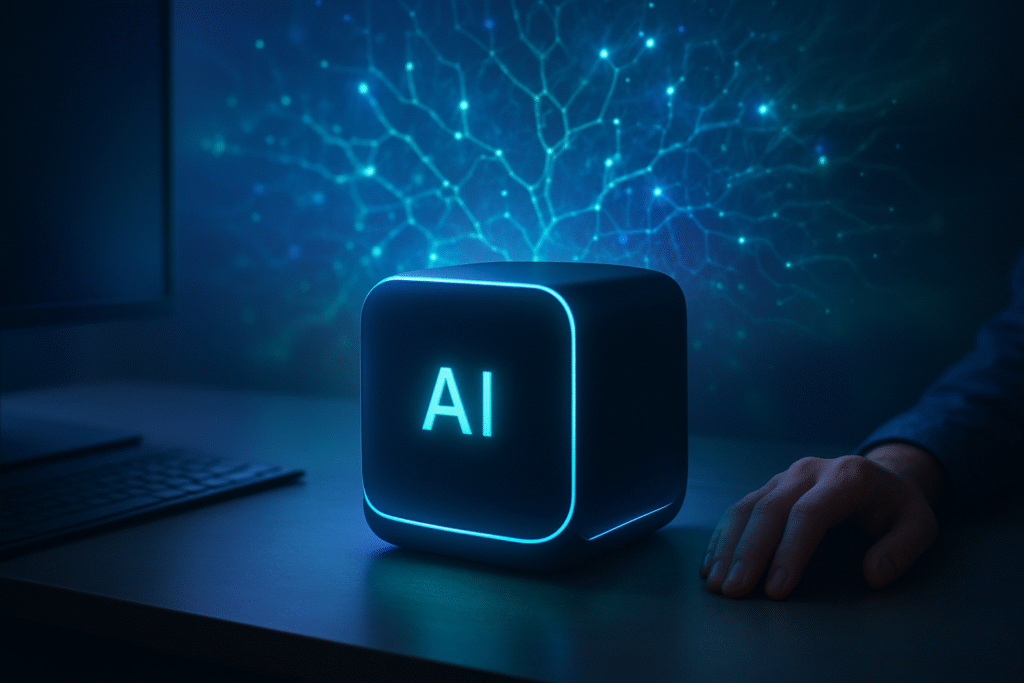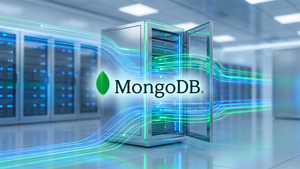
In a pivotal moment for artificial intelligence, NVIDIA (NASDAQ: NVDA) has officially launched the DGX Spark, hailed as the "world's smallest AI supercomputer." This groundbreaking desktop device, unveiled at CES 2025 and now shipping as of October 13, 2025, marks a significant acceleration in the trend of miniaturizing powerful AI hardware. By bringing petaflop-scale AI performance directly to individual developers, researchers, and small teams, the DGX Spark is poised to democratize access to advanced AI development, shifting capabilities previously confined to massive data centers onto desks around the globe.
The immediate significance of the DGX Spark cannot be overstated. NVIDIA CEO Jensen Huang emphasized that "putting an AI supercomputer on the desks of every data scientist, AI researcher, and student empowers them to engage and shape the age of AI." This move is expected to foster unprecedented innovation by lowering the barrier to entry for developing and fine-tuning sophisticated AI models, particularly large language models (LLMs) and generative AI, in a local, controlled, and cost-effective environment.
The Spark of Innovation: Technical Prowess in a Compact Form
At the heart of the NVIDIA DGX Spark is the cutting-edge NVIDIA GB10 Grace Blackwell Superchip. This integrated powerhouse combines a powerful Blackwell-architecture GPU with a 20-core ARM CPU, featuring 10 Cortex-X925 performance cores and 10 Cortex-A725 efficiency cores. This architecture enables the DGX Spark to deliver up to 1 petaflop of AI performance at FP4 precision, a level of compute traditionally associated with enterprise-grade server racks.
A standout technical feature is its 128GB of unified LPDDR5x system memory, which is coherently shared between the CPU and GPU. This unified memory architecture is critical for AI workloads, as it eliminates the data transfer overhead common in systems with discrete CPU and GPU memory pools. With this substantial memory capacity, a single DGX Spark unit can prototype, fine-tune, and run inference on large AI models with up to 200 billion parameters locally. For even more demanding tasks, two DGX Spark units can be seamlessly linked via a built-in NVIDIA ConnectX-7 (NASDAQ: NVDA) 200 Gb/s Smart NIC, extending capabilities to handle models with up to 405 billion parameters. The system also boasts up to 4TB of NVMe SSD storage, Wi-Fi 7, Bluetooth 5.3, and runs on NVIDIA's DGX OS, a custom Ubuntu Linux distribution pre-configured with the full NVIDIA AI software stack, including CUDA libraries and NVIDIA Inference Microservices (NIM).
The DGX Spark fundamentally differs from previous AI supercomputers by prioritizing accessibility and a desktop form factor without sacrificing significant power. Traditional DGX systems from NVIDIA were massive, multi-GPU servers designed for data centers. The DGX Spark, in contrast, is a compact, 1.2 kg device that fits on a desk and plugs into a standard wall outlet, yet offers "supercomputing-class performance." While some initial reactions from the AI research community note that its LPDDR5x memory bandwidth (273 GB/s) might be slower for certain raw inference workloads compared to high-end discrete GPUs with GDDR7, the emphasis is clearly on its capacity to run exceptionally large models that would otherwise be impossible on most desktop systems, thereby avoiding common "CUDA out of memory" errors. Experts largely laud the DGX Spark as a valuable development tool, particularly for its ability to provide a local environment that mirrors the architecture and software stack of larger DGX systems, facilitating seamless deployment to cloud or data center infrastructure.
Reshaping the AI Landscape: Corporate Impacts and Competitive Shifts
The introduction of the DGX Spark and the broader trend of miniaturized AI supercomputers are poised to significantly reshape the competitive landscape for AI companies, tech giants, and startups alike.
AI Startups and SMEs stand to benefit immensely. The DGX Spark lowers the barrier to entry for advanced AI development, allowing smaller entities to prototype, fine-tune, and experiment with sophisticated AI algorithms and models locally without the prohibitive costs of large cloud computing budgets or the wait times for shared resources. This increased accessibility fosters rapid innovation and enables startups to develop and refine AI-driven products more quickly and efficiently. Industries with stringent data compliance and security needs, such as healthcare and finance, will also find value in the DGX Spark's ability to process sensitive data on-premise, maintaining control and adhering to regulations like HIPAA and GDPR. Furthermore, companies focused on Physical AI and Edge Computing in sectors like robotics, smart cities, and industrial automation will find the DGX Spark ideal for developing low-latency, real-time AI processing capabilities at the source of data.
For major AI labs and tech giants, the DGX Spark reinforces NVIDIA's ecosystem dominance. By extending its comprehensive AI software and hardware stack from data centers to the desktop, NVIDIA (NASDAQ: NVDA) incentivizes developers who start locally on DGX Spark to scale their workloads using NVIDIA's cloud infrastructure (e.g., DGX Cloud) or larger data center solutions like DGX SuperPOD. This solidifies NVIDIA's position across the entire AI pipeline. The trend also signals a rise in hybrid AI workflows, where companies combine the scalability of cloud infrastructure with the control and low latency of on-premise supercomputers, allowing for a "build locally, deploy globally" model. While the DGX Spark may reduce immediate dependency on expensive cloud GPU instances for iterative development, it also intensifies competition in the "mini supercomputer" space, with companies like Advanced Micro Devices (NASDAQ: AMD) and Apple (NASDAQ: AAPL) offering powerful alternatives with competitive memory bandwidth and architectures.
The DGX Spark could disrupt existing products and services by challenging the absolute necessity of relying solely on expensive cloud computing for prototyping and fine-tuning mid-range AI models. For developers and smaller teams, it provides a cost-effective, local alternative. It also positions itself as a highly optimized solution for AI workloads, potentially making traditional high-end workstations less competitive for serious AI development. Strategically, NVIDIA gains by democratizing AI, enhancing data control and privacy for sensitive applications, offering cost predictability, and providing low latency for real-time applications. This complete AI platform, spanning from massive data centers to desktop and edge devices, strengthens NVIDIA's market leadership across the entire AI stack.
The Broader Canvas: AI's Next Frontier
The DGX Spark and the broader trend of miniaturized AI supercomputers represent a significant inflection point in the AI landscape, fitting into several overarching trends as of late 2025. This development is fundamentally about the democratization of AI, moving powerful computational resources from exclusive, centralized data centers to a wider, more diverse community of innovators. This shift is akin to the transition from mainframe computing to personal computers, empowering individuals and smaller entities to engage with and shape advanced AI.
The overall impacts are largely positive: accelerated innovation across various fields, enhanced data security and privacy for sensitive applications through local processing, and cost-effectiveness compared to continuous cloud computing expenses. It empowers startups, small businesses, and academic institutions, fostering a more competitive and diverse AI ecosystem. However, potential concerns include the aggregate energy consumption from a proliferation of powerful AI devices, even if individually efficient. There's also a debate about the "true" supercomputing power versus marketing, though the DGX Spark's unified memory and specialized AI architecture offer clear advantages over general-purpose hardware. Critically, the increased accessibility of powerful AI development tools raises questions about ethical implications and potential misuse, underscoring the need for robust guidelines and regulations.
NVIDIA CEO Jensen Huang draws a direct historical parallel, comparing the DGX Spark's potential impact to that of the original DGX-1, which he personally delivered to OpenAI (private company) in 2016 and credited with "kickstarting the AI revolution." The DGX Spark aims to replicate this by "placing an AI computer in the hands of every developer to ignite the next wave of breakthroughs." This move from centralized to distributed AI power, and the democratization of specialized AI tools, mirrors previous technological milestones. Given the current focus on generative AI, the DGX Spark's capacity to fine-tune and run inference on LLMs with billions of parameters locally is a critical advancement, enabling experimentation with models comparable to or even larger than GPT-3.5 directly on a desktop.
The Horizon: What's Next for Miniaturized AI
Looking ahead, the evolution of miniaturized AI supercomputers like the DGX Spark promises even more transformative changes in both the near and long term.
In the near term (1-3 years), we can expect continued hardware advancements, with intensified integration of specialized chips like Neural Processing Units (NPUs) and AI accelerators directly into compact systems. Unified memory architectures will be further refined, and there will be a relentless pursuit of increased energy efficiency, with experts predicting annual improvements of 40% in AI hardware energy efficiency. Software optimization and the development of compact AI models (TinyML) will gain traction, employing sophisticated techniques like model pruning and quantization to enable powerful algorithms to run effectively on resource-constrained devices. The integration between edge devices and cloud infrastructure will deepen, leading to more intelligent hybrid cloud and edge AI orchestration. As AI moves into diverse environments, demand for ruggedized systems capable of withstanding harsh conditions will also grow.
For the long term (3+ years), experts predict the materialization of "AI everywhere," with supercomputer-level performance becoming commonplace in consumer devices, turning personal computers into "mini data centers." Advanced miniaturization technologies, including chiplet architectures and 3D stacking, will achieve unprecedented levels of integration and density. The integration of neuromorphic computing, which mimics the human brain's structure, is expected to revolutionize AI hardware by offering ultra-low power consumption and high efficiency for specific AI inference tasks, potentially delivering 1000x improvements in energy efficiency. Federated learning will become a standard for privacy-preserving AI training across distributed edge devices, and ubiquitous connectivity through 5G and beyond will enable seamless interaction between edge and cloud systems.
Potential applications and use cases are vast and varied. They include Edge AI for autonomous systems (self-driving cars, robotics), healthcare and medical diagnostics (local processing of medical images, real-time patient monitoring), smart cities and infrastructure (traffic optimization, intelligent surveillance), and industrial automation (predictive maintenance, quality control). On the consumer front, personalized AI and consumer devices will see on-device LLMs for instant assistance and advanced creative tools. Challenges remain, particularly in thermal management and power consumption, balancing memory bandwidth with capacity in compact designs, and ensuring robust security and privacy at the edge. Experts predict that AI at the edge is now a "baseline expectation," and that the "marriage of physics and neuroscience" through neuromorphic computing will redefine next-gen AI hardware.
The AI Future, Now on Your Desk
NVIDIA's DGX Spark is more than just a new product; it's a profound statement about the future trajectory of artificial intelligence. By successfully miniaturizing supercomputing-class AI power and placing it directly into the hands of individual developers, NVIDIA (NASDAQ: NVDA) has effectively democratized access to the bleeding edge of AI research and development. This move is poised to be a pivotal moment in AI history, potentially "kickstarting" the next wave of breakthroughs much like its larger predecessor, the DGX-1, did nearly a decade ago.
The key takeaways are clear: AI development is becoming more accessible, localized, and efficient. The DGX Spark embodies the shift towards hybrid AI workflows, where the agility of local development meets the scalability of cloud infrastructure. Its significance lies not just in its raw power, but in its ability to empower a broader, more diverse community of innovators, fostering creativity and accelerating the pace of discovery.
In the coming weeks and months, watch for the proliferation of DGX Spark-based systems from NVIDIA's hardware partners, including Acer (TWSE: 2353), ASUSTeK Computer (TWSE: 2357), Dell Technologies (NYSE: DELL), GIGABYTE Technology (TWSE: 2376), HP (NYSE: HPQ), Lenovo Group (HKEX: 0992), and Micro-Star International (TWSE: 2377). Also, keep an eye on how this new accessibility impacts the development of smaller, more specialized AI models and the emergence of novel applications in edge computing and privacy-sensitive sectors. The desktop AI supercomputer is here, and its spark is set to ignite a revolution.
This content is intended for informational purposes only and represents analysis of current AI developments.
TokenRing AI delivers enterprise-grade solutions for multi-agent AI workflow orchestration, AI-powered development tools, and seamless remote collaboration platforms.
For more information, visit https://www.tokenring.ai/.




